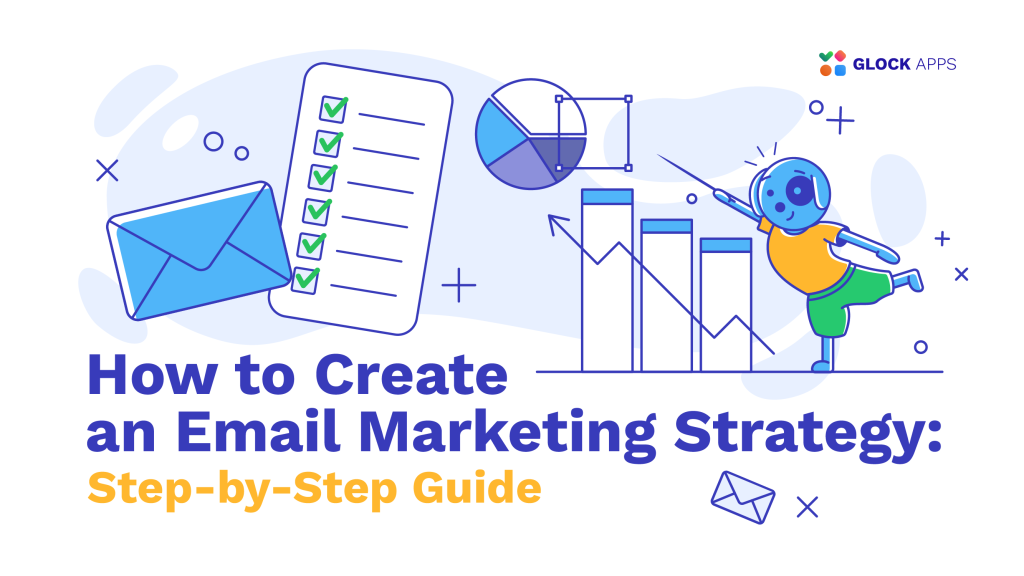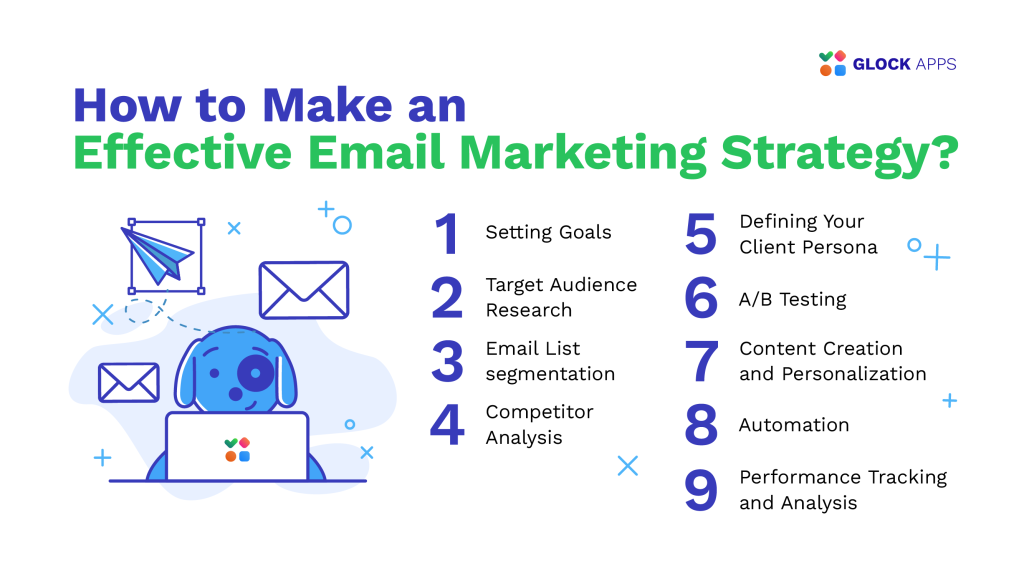How to Create an Email Marketing Strategy: Step-by-Step Guide

What Is an Email Marketing Strategy?
We believe that there is no need to talk too much about the popularity of email marketing, because it is an effective way to directly connect with the target audience, offering great opportunities for engagement and conversion. That’s why a solid email marketing strategy is a fundamental necessity for every business, regardless of size or industry.
An email marketing strategy is a comprehensive plan that describes how your company or organization will use emails to achieve your specific goals. It encompasses various elements, including audience segmentation, content creation, timing, frequency, and performance tracking. Essentially, it serves as a roadmap for using email communication to build and nurture relationships with prospects and customers, ultimately driving desired actions and cultivating brand loyalty.
Key Benefits of Developing an Email Marketing Strategy
You may be wondering how an email marketing strategy can benefit your business. First and foremost, it will help you save a lot of money that you could have wasted on an untargeted campaign. With this advantage, you increase your budget by reaching customers who are more likely to open and interact with your message.
Developing an effective email marketing strategy offers numerous other benefits for your business:
- Proper communication with the audience
- Customer involvement through relevant content and personalized messaging, resulting in higher engagement rates than other marketing channels
- Regular communication via email helps to build relationships and strengthen the trust and loyalty of your clients
- Higher cost-effectiveness compared to traditional marketing methods, offering a high return on investment
- Measurable results and detailed analytics allow you to track the performance of your campaigns and enable data-driven optimization for better results
Types of Email Marketing Strategies
Email marketing campaign strategy includes two main approaches:
- Inbound email marketing is about building relationships with people who have shown interest in your brand or product, such as by visiting your website or engaging with social media advertising, and willingly subscribing to your mailing list. This approach focuses on providing valuable, personalized content that addresses audience needs and offers solutions ranging from helpful tips and guides to exclusive offers. This requires a comprehensive and diversified e-marketing strategy aimed at developing long-term engagement and loyalty.
- Outbound email marketing, conversely, involves reaching out to potential customers who haven’t actively expressed interest in your brand or subscribed to your mailing list. Sending unsolicited emails to individuals who haven’t interacted with your business before characterizes outbound marketing. This typically includes sending cold emails to individuals who fit your target audience profile, hoping to pique their interest in your product or service. However, it’s essential to differentiate between legitimate cold emails and spam, as the latter can damage your brand reputation and email deliverability.
By blending elements of both inbound and outbound strategies, businesses can create a dynamic email marketing approach that engages, converts, and builds lasting connections with their customers.
Read more: AI Powered Email Marketing: Does It Work for Your Brand?
Email Marketing Laws: Ensuring Compliance with Spam Regulations and Privacy Protocols
Comparing Inbound and Outbound Marketing: The Role of Email in Each Strategy
Ultimate Guide To Email Marketing Subject Lines
Email Marketing Statistics: Impressive Data for Your Business Motivation
How to Maximize Inbox Delivery: Best Practices that You Can Implement Today
Unlock the Full Potential of Email Marketing Through Hyper-Personalization
How to Make an Effective Email Marketing Strategy?

Use our step-by-step guide to create an email marketing strategy that actually works:
1. Setting Goals.
Developing a strategy for email marketing must begin with clearly defining company goals and objectives, as this is a fundamental step in any endeavor. Think about what exactly you are trying to achieve: increase sales, drive website traffic, strengthen brand awareness, or enhance customer relationships.
Once you’ve defined your goals, adapt your strategy accordingly by setting specific, measurable goals to track your progress and evaluate success. By linking your email marketing efforts to your core business goals, you can create targeted campaigns that deliver tangible results for your organization.
2. Target Audience Research.
Conduct thorough research to understand the demographics, preferences, behaviors, and pain points of your target audience. To stay informed and proactive use tools like surveys, analytics data, and social media statistics to gather valuable information that helps build your segmentation strategy and content creation plan.
3. Email List Segmentation.
Fine-tune your mailing list segmentation based on demographics, behavior, or preferences to deliver targeted content that resonates with each group.
4. Competitor Analysis.
No need to explain that competitor analysis is a key step for all email marketing strategies and tactics. It performs several important functions, starting with keeping up with industry trends. By observing your competitors’ campaigns, you can gain insight into new strategies, content formats, and engagement tricks. This knowledge helps you stay ahead of the curve and ensure your messages stay relevant and effective.
In addition, in-depth competitor analysis helps identify untapped opportunities in the market. By identifying gaps or areas where other companies are not performing yet, you can use these options to differentiate your brand and gain a competitive advantage. This strategic move allows you to meet the unmet needs and solve the problem points of your target audience. This is a crucial part of your marketing planning, as it allows you to meet the unmet needs and solve the problem points of your target audience. Therefore, begin by subscribing to the mailing list of all competitors and continuously monitor their main tactical techniques.
5. Defining Your Client Persona.
Developing client personas helps humanize your target audience and guides content creation and messaging. It’s crucial to ensure that your communications resonate with your audience.
To create a customer persona, start by gathering data on demographics, preferences, and behaviors from audience research and competitor analysis. Then use this information to shape a detailed profile that represents your ideal customer, including their interests, concerns, goals, and pain points. This persona will serve you as a guiding framework for tailoring all marketing efforts.
6. A/B Testing.
Implement A/B testing to optimize your email campaigns for maximum effectiveness. Test different elements such as subject lines, design styles, content formats, CTAs, and send times to identify which variations resonate best with your audience and drive the highest engagement and conversion rates.
A/B tests are useful because they allow you to experiment with various versions of your emails to determine which one resonates best with your audience. This data-driven approach helps to refine your email marketing strategy template, improve campaign performance, and ultimately achieve better results.
7. Content Creation and Personalization.
Great content drives actions. It grabs attention and inspires your readers to take the next step, whether it’s making a purchase, visiting your website, or sharing some information with others.
That’s why developing compelling and relevant content tailored to your segmented audience groups and client personas – is a must. By delivering content that truly matters to your subscribers, you demonstrate your commitment to building a strong community, and not just selling them something. Read our helpful tips on how to write a perfect cold email to easily craft powerful messages.
8. Automation.
Don’t hesitate, automate all repetitive tasks like welcome emails, drip campaigns, follow-ups, re-engagement emails, and abandoned cart reminders. This way you can deliver timely, personalized messages that encourage leads and effectively drive conversions.
An email marketing automation strategy involves setting up automated workflows to send targeted emails to your segmented audience groups, making your work routine easier and more efficient. By automatically setting up and sending your emails you can quickly adapt to evolving trends, continuously change strategy, and drive sustained brand growth. Using automatic software will free up your time to work on other urgent tasks.
Integrate an email marketing calendar into your automation strategy to help you plan and visualize your campaigns in advance, ensuring consistent messaging, timing, and frequency. This will allow you to coordinate your mailing with other marketing initiatives, seasonal promotions, and important events, resulting in a cohesive and strategic approach to communication. In addition, an automatic calendar will help you stay organized, and importantly keep track of deadlines and avoid overlaps or gaps in your messaging schedule.
9. Performance Tracking and Analysis.
After all, it doesn’t matter how optimized your emails are if you’re still not tracking analytics properly and aren’t sure which metrics to focus on. The best email marketing strategy requires focus and knowledge and should include all stages of performance tracking and analysis to ensure continuous improvement and achievement of marketing goals. Tools like Funnel.io allow you to track and monitor all of your marketing metrics together in one place.
To measure the effectiveness of your email campaign and make informed decisions based on data, constantly monitor and analyze key indicators.
Here are the main email marketing metrics to keep an eye on:
- Open Rate
- Click-Through Rate (CTR)
- Conversion Rate
- Bounce Rate
- Unsubscribe Rate
- List Growth Rate
- Email Sharing and Forwarding
- Device and Browser Metrics
- Engagement Rate
- Segmentation Performance
- Return on Investment (ROI)
Also, the key to a successful email marketing strategy is a clear understanding of deliverability metrics. Prioritize tracking indicators such as:
- Email Placement (Inbox, Tabs, Spam, Missing)
- Spam rate
- User Reported Spam Rate
- Sender Score
- Sender Reputation
- Delivery Timing
Track and transform your campaigns with the Inbox Insight tool from GlockApps, try it free, receive detailed reports, and proactively assess your deliverability. Use all the insights you get from your performance data to identify trends, indicate potential issues, optimize your email marketing strategies and tactics, and come up with ideas for further improvement.
Learn more: ISPs and ESPs: What It Is and How to Choose
Email Marketing Trends in 2025: What to Expect and How to Stay Ahead
10 Email Marketing Goals for 2025 from GlockApps
Key Email Marketing Metrics You Need to Know to Succeed
The Best Free Email Marketing Tools to Save Budget and Time
B2B and B2C Email Marketing Strategies – Understanding the Differences
Email Customer Journey: How to Map, Automate, and Optimize Your Email Marketing Strategy
Email Marketing Calendar: Strategic Planning and Automation of Your Campaigns [+Templates]
Wrapping Up
Remember, only a well-designed and customized email marketing strategy for your unique goals and audience is the foundation of sustainable growth and impact for your efforts. Always keep refining and optimizing your tactic over time to adapt to changing trends and continue to deliver decent results.
Focus on creating truly high-quality content, involve segmentation and automation to ease your routine, check out the latest market statistics, and pay attention to monitoring key email marketing and deliverability metrics. To understand what is the most effective email marketing strategy, study your competitors in detail and learn from them positive experiences, stay on top of the latest trends, and always put yourself in the place of the recipient of your letter.
You, as the author, are the main critic of your email campaign, so do not spare time to evaluate it from the subscriber’s point of view, this will help you to be closer to the target audience and will definitely give good final results.



